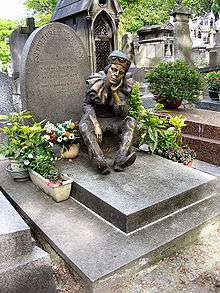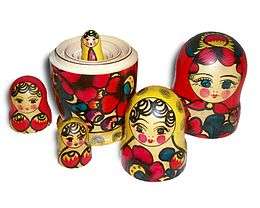Petrushka
Petrushka (Russian: Петру́шка, IPA: [pʲɪtˈruʂkə] (![]()


Word origin
Although the Russian word "petrushka" has a homonym meaning "parsley", in this context the word is actually a hypocoristic (diminutive) for "Pyotr" (Пётр), which is Peter in Russian. Despite this, the character has little or nothing in common with the commedia dell'arte stock characters of Petruccio or Pierrot, but is instead a Russian version of Punch or Pulcinella.
History
Pietro-Mira Pedrillo of Italy, the court jester of the Empress Anna Ioannovna, allegedly served as a prototype for Petrushka.
Like Punch, Petrushka's voice was created with the help of a special whistle, and the dialogue was based on a momentary change of the pishchik and the "live" voice of other characters. There were a number of basic plots: the medical treatment of Petrushka, his learning of soldier’s service, the scene with his bride, and the buying of a horse and testing it.
Initially, Petrushka was characteristic of typical slapstick comedy, targeting an adult audience. As puppet theatre gradually became a predominantly children's entertainment, Petrushka became less vulgar and aggressive. In the Soviet Union, Petrushka appeared widely in agitprop theater, defending poor peasants and attacking kulaks.[2]
The Russian Children's Welfare Society (RCWS) hosts an annual "Petroushka Ball", which is named after a version of the Petrushka character who fell in love with a graceful ballerina.[3]
See also
- Guignol
- Petrushka (ballet), music by Igor Stravinsky
- Punch and Judy
References
- Catriona Kelly, "From Pulcinella to Petrushka: The History of the Russian Glove Puppet Theatre." Oxford Slavonic Papers 21 (1988): 41-63.
- Richard Pipes, Russia Under the Bolshevik Regime, p305, ISBN 978-0-394-50242-7
- RCWS.org
External links
| Wikimedia Commons has media related to Petrushka. |
- Petrushka (in Russian)
- Petrushka and Vertep: On Traditions of Russian Puppet Theatre (in English)

